Precautions against clarinet cracking in winter
Clarinet U Article

One of the main precautions we have to consider with our clarinet is to avoid undesirable splits, basically in wood clarinets which are more prone to cracking in winter. Why this happens?
According to the Yamaha musical instrument maintenance guide, the reason depends on the room temperature, where the clarinet may be fairly cold in winter before it is played.
Therefore, when the clarinetist blows into the instrument, the inside of the body of the clarinet will be warmed up at the same as his body temperature, around 36ºC and 37ºC (around 97°F). Consequently, the wood will try to expand outwards and since the outside of the instrument is already constricted by the low external temperature, the clarinet may be unable to withstand this temperature difference and crack.
So, in order to protect the clarinet from cracking, we must blow air through the instrument prior to playing to warm it up, as well as taking the clarinet out of its case, warm it up by putting it inside a coat or pressing it against our body. Keep in mind the upper body is most prone to cracking, which is most easily warmed by the breath of the clarinetist.
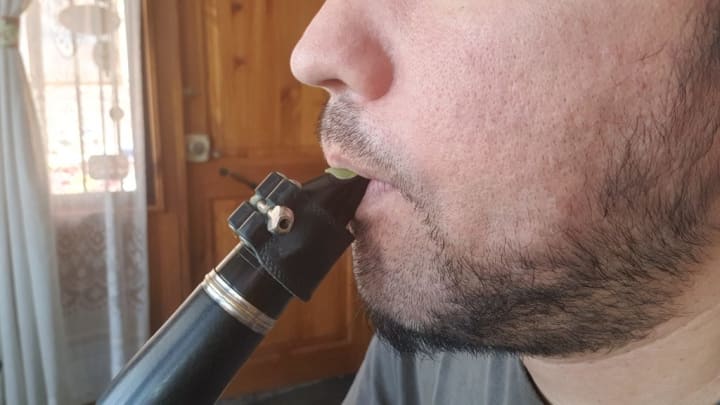
To protect the clarinet from cracking, we must blow air through the instrument prior to playing to warm it. (Manuel García)
In the case you do not see any cracks in the clarinet, you should inspect it very carefully. If you find cracks, take it to a specialist shop as quickly as possible, because the cracking will gradually spread, making repair progressively more difficult. In the worst case, the clarinet may even break apart.

The upper body of the clarinet is most prone to cracking, which may even break apart. (Alexander Jara)

The cracking in a joint of a clarinet. (Alexander Jara)
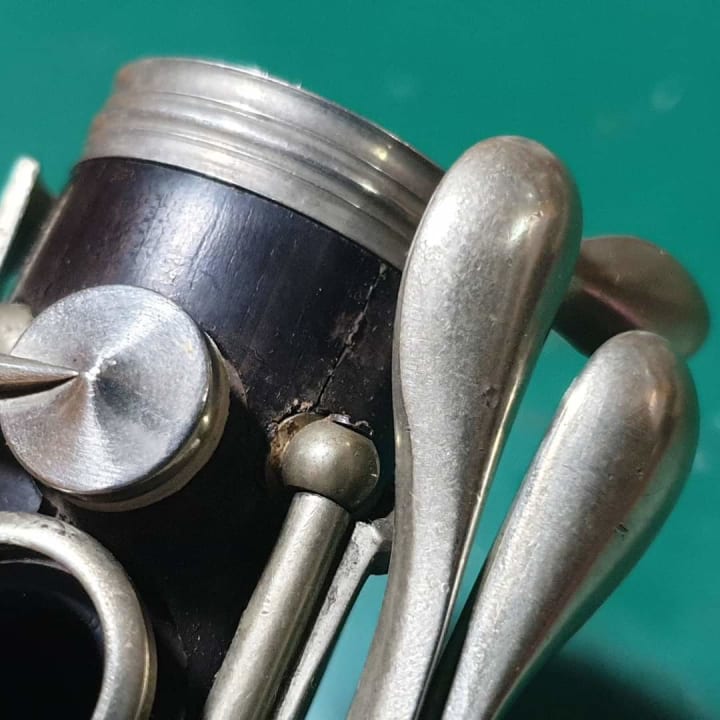
It is important to keep our clarinet free of cracks. (Alexander Jara)
Another situation that can damage clarinets besides temperature difference is drastic difference in humidity, so special care is also required in winter.
One method of dealing with this condition is to use bore oil, which protects against changes in the internal shape of the instrument by absorbing moisture in the tube.
Before using it, first remove the moisture from inside the tube and clean it carefully. Then soak a little bore oil into a swab and spread the oil around inside the clarinet in order to form a thin film of bore oil over the instrument's interior surface.
Make sure not to apply too much bore oil in the clarinet. Limit oiling to every two to three months for new instruments and once a year for older instruments.

Bore oil is perfect to hydrate wood clarinets and helps to preserve the natural features of the instrument. (Trinomusic.com)
Corks are also very important in the maintenance, which may harden in cold temperatures and it will be very difficult to put your clarinet together. You must never force putting your clarinet together because the corks might tear, or the keys can be loose and deformed by the force. Use cork grease for it in order to put your clarinet together easily.
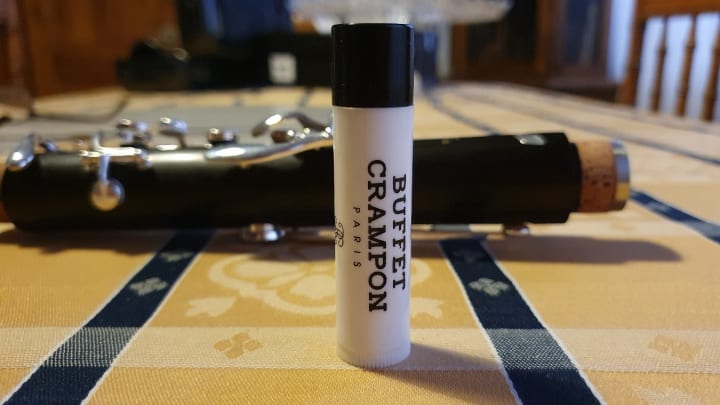
Use always cork grease to put your clarinet together easily. (Manuel García)
Thus, if we follow these useful tips of maintenance we will be able to keep our clarinet free of cracks, especially in winter where wood clarinets are more exposed to temperature fluctuations before they can be played.
---
Spanish version (en español):
Precauciones para evitar el agrietamiento del clarinete durante el invierno
Una de las principales precauciones que debemos que tener con nuestro clarinete es evitar que se produzcan rajaduras indeseadas, fundamentalmente en los clarinetes de madera los cuales son más propensos a sufrir grietas durante el invierno. ¿Por qué sucede esto?
Según la guía de mantenimiento en instrumentos musicales de Yamaha, todo va a depender de la temperatura ambiente en la que se encuentre el instrumento, el cual puede estar bastante frío en invierno antes de tocarlo.
Es por ello que cuando el clarinetista sopla a través del instrumento, el interior del cuerpo del clarinete se calentará a la misma temperatura del cuerpo del clarinetista, es decir, alrededor de 36ºC y 37ºC, lo que, en consecuencia, provocará que la madera intentará expandirse hacia el exterior. Sin embargo y dado que el instrumento ya estará expuesto a las bajas temperaturas, es posible que el clarinete no pueda soportar esta diferencia de temperatura y se agriete.
Para evitar el agrietamiento del instrumento, lo que se debe hacer es soplar aire a través del clarinete antes de tocarlo, así como también sacar el instrumento del estuche para calentarlo dentro de un abrigo o presionarlo contra el cuerpo. Hay que tener en cuenta que la parte del clarinete que es más propensa a romperse es la parte superior del cuerpo, la cual se calienta más fácilmente con el flujo del aire del clarinetista.
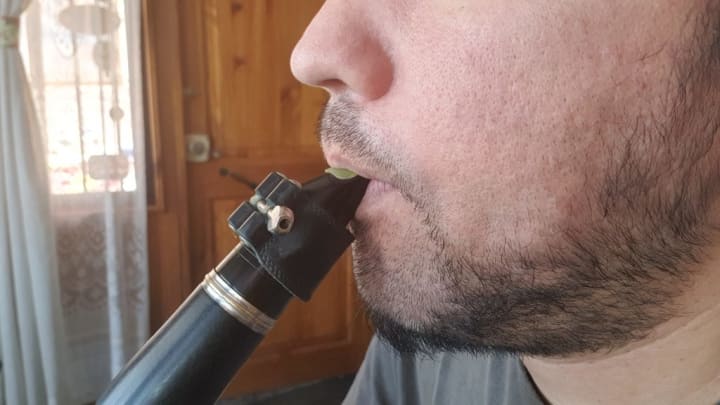
Para evitar el agrietamiento del instrumento, lo que se debe hacer es soplar aire a través del clarinete antes de tocarlo. (Manuel García)
En caso de no observar grietas, de vez en cuando hay que revisar el instrumento cuidadosamente. De llegar a encontrar rajaduras, será necesario llevarlo a un taller especializado para que lo reparen lo más rápido posible, ya que las grietas se extenderán paulatinamente, dificultando progresivamente la reparación. Incluso y en el peor de los casos, el clarinete podría llegar a quebrarse.
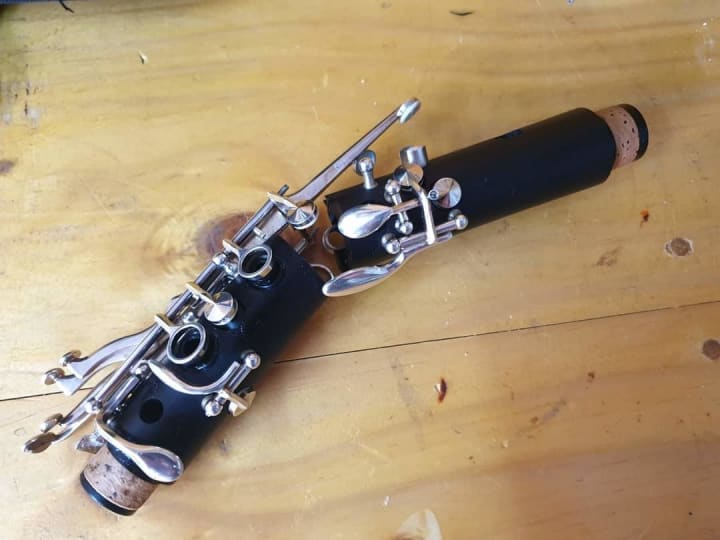
El cuerpo superior del clarinete es la parte más propensa a sufrir grietas, el cual incluso podría llegar a quebrarse. (Alexander Jara)

Una rajadura en una de las junturas de un clarinete. (Alexander Jara)
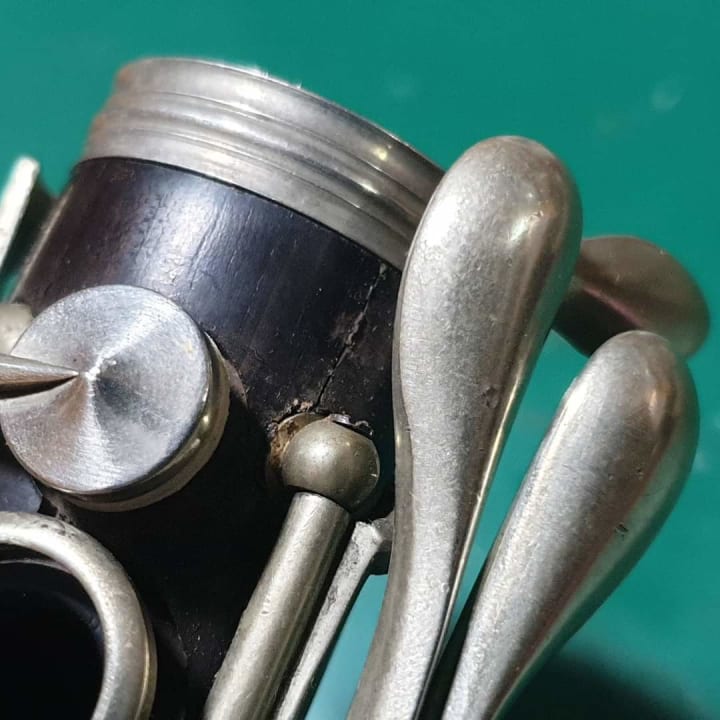
Es importante mantener nuestro clarinete libre de rajaduras. (Alexander Jara)
Un método que sirve para combatir la humedad es el "Bore Oil", un aceite hidratante que protegerá al instrumento contra los cambios al interior de este al absorber la humedad en el tubo.
Es por ello que antes de utilizarlo, será necesario remover la humedad dentro del tubo y hacer una limpieza profunda, para luego mojar un poco de aceite en un hisopo y esparcirlo por el interior del clarinete, lo que formará una película delgada al interior de la superficie del instrumento.
Tenga en cuenta de no aplicar demasiado aceite en el clarinete. Hay que restringir su uso cada dos o tres meses en instrumentos nuevos y una vez al año en instrumentos usados.

El "Bore Oil" es el aceite ideal para hidratar clarinetes de madera y ayuda a preservar las características naturales de nuestro instrumento. (Trinomusic.com)
Otro punto importante son los corchos, los cuales podrían llegar a endurecerse por el frío haciendo muy difícil el ensamble del clarinete, por lo que es fundamental no forzar el instrumento ya que los corchos podrían romperse. Para ello, será necesario utilizar grasa de corcho para poder ensamblar el clarinete sin problemas.
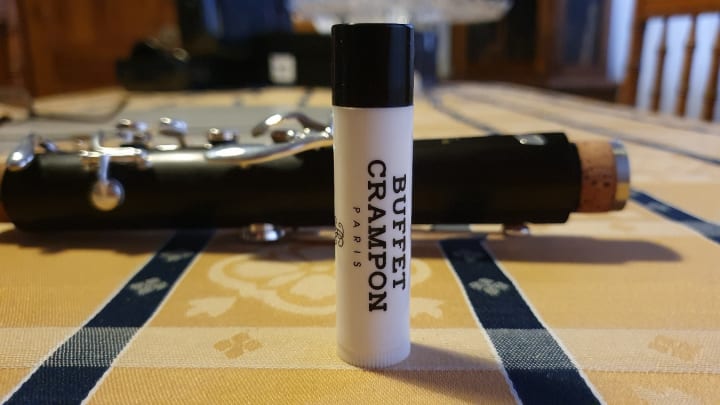
Ocupa siempre grasa de corcho para ensamblar el clarinete con facilidad. (Manuel García)
Es así como si seguimos estos útiles consejos mantendremos nuestro clarinete libre de rajaduras, sobre todo en la temporada de invierno donde principalmente los clarinetes de madera se ven más expuestos a los cambios de temperatura antes de poder tocarlos.
Written by Manuel García
Published by Clarinet U
Manuel García, Chilean journalist, clarinetist and translator. With more than 20 years playing the clarinet, Mauel have been a member of many camera orchestras since 17 years old to the present. Currently he has website named "El Rincón del Clarinetista". It includes exclusive content about clarinet news, interviews and topics of interest dedicated to both amateur and professional clarinetists.
Follow Manuel on instagram:
@mangarvid and @elrincondelclarinetista.cl
Website: www.elrincondelclarinetista.cl

About the Creator
Clarinet U
We believe Clarinet is the most beautiful instrument.
Clarinet U is an online platforms that focuses on clarinet online marketplace, lessons, and resources for all clarinetists.
www.clarinetu.com






Comments
There are no comments for this story
Be the first to respond and start the conversation.